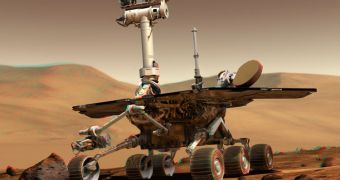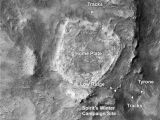It's been called "Home Plate" and it's a rocky outcrop presenting unusual layered features that has the shape of a baseball home plate. This weird feature on Mars' surface has puzzled astronomers ever since its discovery and now MER-A (Mars Exploration Rover - A), known as Spirit, the first of the two rovers of NASA's Mars Exploration Rover Mission that landed successfully on Mars on January 4, 2004, has provided new clues regarding its formation.
Astronomers have previously theorized about its origins and they considered the effects of wind and sand deposits as possible explanations, but now Spirit has shown the first conclusive evidence of volcanic activity, by intensely studying its appearance and geological composition.
The rover mapped the strange formation and the analysis shows that the outcrop was most likely formed due to volcanic activity, by layers of ejected volcanic materials. During that activity, larger grains of debris were buried under layers of finer materials and they were later rearranged by wind. Moreover, it found that Home Plate contained a "bomb sag," a depressed area on the ground where a rock, or "bomb," would have fallen.
The result was this rocky outcrop around the size of a large mansion, but having a flat-topped shape and looking almost pentagonal. Located in the Gustav crater, just South of Husband Hill, it stands a few yards high and 260 to 295 feet (80 to 90 meters) across.
"It's the first really powerful evidence that either rover has found for explosive materials [on Mars]," said Steve Squyres, an astronomer at Cornell University and principal investigator of the rovers' mission.
This new "bomb" crater pattern was widely accepted by astronomers. "That provided compelling evidence that this was a case where there had been an explosion," Squyres said.
The results were possible due to the extensive work of Spirit Rover, which has continued to function effectively over ten times longer than NASA planners expected, allowing it to perform extensive geological analysis of Martian rocks and planetary surface features.

 14 DAY TRIAL //
14 DAY TRIAL // 
